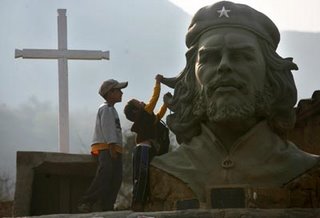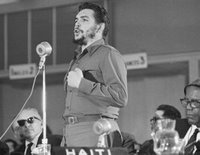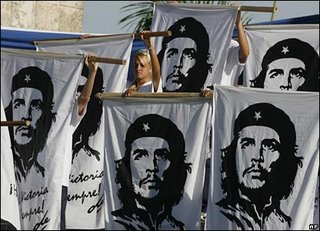 All around the world this week, parlor-room socialists are celebrating the 40th anniversary of the death of Ernesto “Che” Guevara. But it would not surprise me to learn that 99.9% of them have no clue who Che really was, or why they’re idolizing him.
All around the world this week, parlor-room socialists are celebrating the 40th anniversary of the death of Ernesto “Che” Guevara. But it would not surprise me to learn that 99.9% of them have no clue who Che really was, or why they’re idolizing him.
After all, Che was little more than a middle-class doctor from Argentina who suffered a premature mid-life crisis. Instead of buying a fast car and taking a mistress, however, he decided to emulate the movie character made famous by James Dean – by becoming a rebel…with a cause. That cause, of course, was a quixotic mission to establish a new world order based on the egalitarian tenets of communism.
Although, it probably reflected an abiding death wish that Che had no patience for the non-violent political agitation that overturned unjust social orders everywhere from the Philippines to the Soviet Union and South Africa. In fact, he manifested a romantic obsession with guerrilla warfare that smacked of suicidal ideation. Moreover, it’s probably no coincidence that he had his socialist epiphany while touring South and Central America in James-Dean style… on a motorbike.
Meanwhile, one wonders why Che did not exorcise his revolutionary demons by participating in the series of political uprisings that made Argentina a rebel’s paradise during the 1950’s. Instead, fate led him to Mexico in 1954, where he met a bona fide Communist revolutionary, Fidel Castro. And soon Castro’s cause (of overthrowing the dictatorship of Cuban President Fulgencio Batista) became Che’s.
Alas, being cast as a supporting actor in Castro’s dictatorship did little to satisfy his antic lust for rebellion. Therefore, after spearheading Cuba’s ill-fated alliance with the Soviet Union (in his capacity as minister of industry and roving ambassador), Che left his now embargoed communist Shangri La in 1966 – purportedly to lead new revolutions in Africa.
 But it took African guerrilla fighters little time to determine that he was more of a rhetorical firebrand (who could even make the notoriously loquacious Fidel seem taciturn) than a guerrilla fighter.
But it took African guerrilla fighters little time to determine that he was more of a rhetorical firebrand (who could even make the notoriously loquacious Fidel seem taciturn) than a guerrilla fighter.
 Accordingly, within months, Che was back in Cuba wondering where in the world he could replicate Castro’s revolution to vindicate his own political calling.
Accordingly, within months, Che was back in Cuba wondering where in the world he could replicate Castro’s revolution to vindicate his own political calling.
It seems fitting, however, that his itinerant life – as a revolutionary in search of a revolution – ended abruptly in the country named after the man who has inspired all Latin American revolutionaries, Simon Bolivar. Because, after traveling to Bolivia to lead a rag-tag bunch of wannabe rebels in their fight to overthrow the government of René Barrientos Ortuño, Che was captured in short order and summarily executed on 9 October 1967.
Yet, despite his failures on the battlefield, there’s no denying that no one acted (or evidently looked) more like a revolutionary than Che. But this only meant that he had far more in common with James Dean than with Fidel Castro. Indeed, nothing became of Che’s revolutionary mission quite like his dying a martyr at age 39; just as nothing became of Dean’s acting talent quite like his dying a matinee idol at age 24.
 Therefore, keep this is mind the next time you see the iconic picture of Che emblazoned on someone’s T-shirt. Because chances are that that person can’t can even say, let alone spell, his name.
Therefore, keep this is mind the next time you see the iconic picture of Che emblazoned on someone’s T-shirt. Because chances are that that person can’t can even say, let alone spell, his name.
There is no other image like it. What other image has been sustained in this way? Che Guevara has become a brand. And the brand’s logo is the image, which represents change. It has becomes the icon of the outside thinker, at whatever level – whether it is anti-war, pro-green or anti-globalisation.
Its presence – everywhere from walls in the Palestinian territories to Parisian boutiques – makes it an image that is “out of control. It has become a corporation, an empire, at this point. [Trisha Ziff, the curator of a touring exhibition on the iconography of Che]
Apropos exploiting Che, leave it to President Hugo Chavez to announce that he’s giving all doctors working for Venezuela’s public health system a 60 percent pay raise to commemorate this anniversary of his death. Never mind that Che betrayed his Hippocratic Oath – namely, “Never to do deliberate harm to anyone for anyone else’s interest” – by inciting bloody revolutions all over the world.
Finally, I’m looking forward to Castro’s televised death-bed confession, in which he tells the world just how much he resents the way profiteers have mythologized Che from a socialist dilettante into a revolutionary icon. Especially since idolizing Che has overshadowed his leadership, and will no doubt undermine his legacy.
NOTE: It seems a cruel irony that Che’s legacy as a communist icon is rivaled by his legacy as a capitalist tool. Which begs the question: Are his children raking in royalties from the use of his image the way Lisa Marie is doing from the marketing of Elvis?
The answer, unfortunately, is no. For starters, copyright on the image, taken in 1960, belonged to Cuban photographer Alberto Korda Díaz, who died in 2001. But he famously rejected all royalties, and insisted only that the image be used consistent with Che’s mission. And since Korda’s death, Che’s heirs have attempted to enforce this public-spirited use of the image. Alas, given that it adorns everything from bikinis to kitchen appliances, their mission seems as doomed to failure as Che’s turned out to be….
Related Articles:
He lives! Rumors of Castro’s death prove greatly exaggerated
Hero file mini bio of Che
Che Guevara
Leave a Reply
You must be logged in to post a comment.